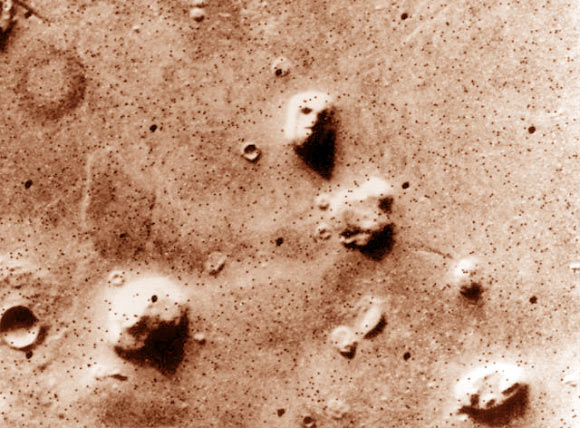Face pareidolia is the phenomenon of seeing face-like structures in everyday objects. It is a very human condition that relates to how our brains are wired. According to new research published in the journal Psychological Science, we process ‘pareidolia faces’ using the same visual mechanisms of the brain that we do for real ones.

NASA’s Viking 1 orbiter photographed the Cydonia region in the northern latitudes of Mars on July 25, 1976 while searching for a landing site for the Viking 2 lander. The speckled appearance of the image is due to missing data, called bit errors, caused by problems in transmission of the photographic data from Mars to Earth. Bit errors comprise part of one of the ‘eyes’ and ‘nostrils’ on the eroded rock that resembles a human face near the center of the image. Shadows in the rock formation give the illusion of a nose and mouth. Planetary geologists attribute the origin of the formation to purely natural processes. The feature is 1.5 km across, with the Sun angle at approximately 20 degrees. The picture was taken from a range of 1,873 km. Image credit: NASA / JPL.
The phenomenon of recognizing faces in everyday objects is experienced widely. For example, collections of objects that look like faces are widespread on social media sites such as Twitter, Reddit, and Flickr, accumulating thousands of usercontributed photos.
Interestingly, many pareidolia objects not only resemble faces but also evoke specific mental or communicative content; for example, the facade of a building might appear to be staring back at you, and a bell pepper might have a happy look.
The human brain has evolved to rapidly detect the presence of other people in our environment and to make inferences about qualities such as their personal identity, emotional state, and direction of attention on the basis of specific sensory cues.
Pareidolia can be understood as a striking false positive in these systems, in which visual mechanisms that are specialized to detect and extract sensory cues from human faces are spontaneously recruited in the absence of a real human form.
Alternatively, the face-like nature of pareidolia objects might simply be a cognitive or mnemonic association with only limited engagement of the visual pathways that process human faces.
“Why does face pareidolia occur? To answer this question we need to look at what face perception involves,” said Dr. Colin Palmer, a researcher in the School of Psychology at the University of New South Wales.
“While human faces all look a bit different, they share common features, like the spatial arrangement of the eyes and the mouth.”
“This basic pattern of features that defines the human face is something that our brain is particularly attuned to, and is likely to be what draws our attention to pareidolia objects.”
“But face perception isn’t just about noticing the presence of a face. We also need to recognize who that person is, and read information from their face, like whether they are paying attention to us, and whether they are happy or upset.”
“This process relies on parts of our brains that are specialized to extract this type of information from what we see.”
In the study, Dr. Palmer and University of New South Wales Professor Colin Clifford tested whether the same mechanisms in the brains that extract important social information when one person looks at another are also activated when we experience face pareidolia.
They tested this using the process known as ‘sensory adaptation,’ a kind of visual illusion where one’s perception is affected by what has recently been seen.
“If you are repeatedly shown pictures of faces that are looking towards your left, for example, your perception will actually change over time so that the faces will appear to be looking more rightwards than they really are,” Dr. Palmer said.
“There is evidence that this reflects a kind of habituation process in the brain, where cells involved in detecting gaze direction change their sensitivity when we are repeatedly exposed to faces with a particular direction of gaze.”
“For example, people who were repeatedly exposed to faces that were looking to the left would, when presented with a face looking directly at them, say that the other’s eyes were looking somewhat to the right. This phenomenon has been noted in past studies.”
The scientists found that repeated exposure to pareidolia faces that conveyed a specific direction of attention — for example, objects that appeared to be ‘looking towards the left’ — caused a change in the perception of where human faces are looking.
This is evidence of overlap in the neural mechanisms that are active when we experience face pareidolia and when we look at human faces.
What this means is if you feel like a pareidolia object is looking at you, or conveys some sort of emotion, it may be because the features of the object are activating mechanisms in your brain that are designed to read that kind of information from human faces.
“So we think face pareidolia is a kind of visual illusion,” Dr. Palmer said.
“We know that the object doesn’t really have a mind, but we can’t help but see it as having mental characteristics like a ‘direction of gaze’ because of mechanisms in our visual system that become active when they detect an object with basic face-like features.”
_____
C. J. Palmer & C. W. G. Clifford. 2020. Face Pareidolia Recruits Mechanisms for Detecting Human Social Attention. Psychological Science 31 (8): 1001-1012; doi: 10.1177/0956797620924814







